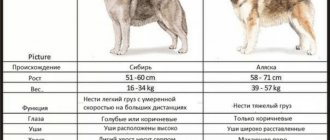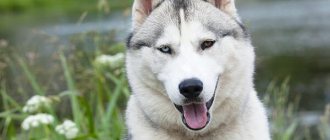Huskies have long been popular among dog breeders.
However, despite the fact that this breed is quite strong and healthy, when breeding them it is necessary to take into account some of the characteristics of these animals, related to the fact that they were originally bred to work in the North, and therefore, in terms of physiology, they are somewhat different from other dogs.
On what day of heat should you breed?
How long does pregnancy last in small and large breed dogs?
Estrus lasts an average of 21 days. In the first few days, the dog begins to have bloody discharge. At this time, the animal is interested in males, but does not let them near.
On days 10-15, the husky bitch ovulates. This period is considered the most favorable for mating. The loop swells significantly, the discharge becomes lighter and more scarce.
A fairly accurate method for determining the day of mating is to examine a smear taken from the bitch’s vagina. It begins to be done a week after the start of estrus. The imminent onset of ovulation is indicated by a rapid increase in the number of keratinizing cells (more than 80%).
How many puppies does a Husky have in the first litter?
Having a good friend and an intelligent animal in the person of a husky bitch, you, of course, had thoughts about the continuation of the offspring of these dogs. A cheerful and easy-going character in tandem with high intelligence, which is inherent in this species, captivates many. They are wonderfully disposed towards humans, hardy and non-aggressive, amenable to training, and able to think. They are unpretentious in care, can easily tolerate different temperatures and can get along with both your child and other pets. These and other advantages and advantages of the breed push you to the decision to get offspring from four-legged pets. But before you arrange a mating for your dog, it is worth considering several nuances and rules.
First of all, you need to understand that you are breeding puppies, first of all, for yourself, and not for sale. They will need to be dealt with, devote time, and incur certain material expenses. If you don’t have such an opportunity or desire, then you shouldn’t do it.
Many people think that all problems are solved as soon as a buyer is found, but this is not true. Sometimes it is very difficult to find a worthy owner for kids. No one can guarantee that a person will not decide to move, change his lifestyle, and that, at the same time, everyone, the pet will not fade into the tenth plane.
There are often cases when a potential owner, although it would seem to carefully listen to the recommendations and instructions of the breeder, but having adopted the animal, neglects everything he had previously heard and neglects the health and education of his pet. If you are still confident in your abilities and are ready to take responsibility for the life of your pet’s kids, then it’s time to find a suitable candidate for the role of “dad”.
Preparation for mating
Mandatory preparatory procedures include:
- Taking a smear for bacteriological diseases: herpes, chlamydia, ureaplasma and mycoplasmosis.
- Blood tests (general and biochemical tests).
- Ultrasound examination of the abdominal cavity.
- Heart examination (ECG, ultrasound if necessary).
- Deworming (1-2 months before mating).
Husky heat: when does it start, how long does it last and how often does it happen?
Animals are given a good walk before mating. You should not feed your pet 2-3 hours before mating.
For reference! If dogs are bred for the first time, it is recommended to invite an experienced specialist.
What to do first
In order for a dog’s pregnancy to take place and proceed favorably, it is necessary to prepare the bitch for this moment. Evaluate all the pros and cons so that this event brings joy to both you and your pet. And we will help you figure it out.
If you decide that you are mentally ready to endure your dog’s pregnancy and childbirth, then you need to make sure whether she is ready to understand and accept your wishes. Asking the dog about this directly, as you understand, will not work.
Therefore, we recommend first of all:
contact specialists - veterinarians
take blood and urine tests to identify diseases or inflammatory processes in the dog;
if necessary, conduct ultrasound diagnostics of the abdominal cavity and perform an ECHO of the heart;
before mating, carry out deworming;
pay attention to the sources of inflammatory processes - ears, gums, para-anal glands;
Determine with a veterinarian the favorable period so that the mating of the bitch will most likely take place;
remember the mating date, this will later serve as a guide to the timing and stages of your dog’s pregnancy.
How does mating happen?
How long does pregnancy last in cats: duration
A mandatory rule is that mating must be carried out on the territory of the dog, but it is possible to carry it out in a place that is neutral for both dogs.
First, the animals get to know each other and sniff each other. After some time, the male begins to mount. If necessary, the bitch can be held by the collar or under the belly. After successful mounting, the dogs stand in a “lock” tail to tail. The duration of this period is 15-60 minutes.
After successful boarding, the dogs stand in the “lock”
Important! Animals should not be forcibly disengaged, as this will lead to injuries to the genitals.
Heading 1
Subtitle
How long does pregnancy last for a cat
“+num_H2+”. "+val.text+"
"+num_H2+." "+num_H3+". "+val.text+"
First trimester
Second trimester
Third trimester
- CHILDREN
Months
The fourth month marks the transition of your baby to your “full board”. Now he will receive nutrients from you through a fully formed common organ - the placenta. Almost until the end of pregnancy, it will be the main metabolic organ of the fetus.
The developing body of a child is very demanding, so you will have to strictly monitor the “supply” of proteins, fats and carbohydrates. Glucose is the main source of energy for the baby, amino acids are the building material for new cells, and fats are necessary for building the substance of the brain and lungs. All these components actively penetrate to the baby through the placenta from your body. However, you should not think that the placenta is permeable to absolutely all substances. It becomes a barrier to antibiotics and many other substances dangerous to the child. That is why, from the moment it finally matures, doctors begin to treat diseases that require the use of serious medications.
In the 4th month of pregnancy, the baby’s brain continues to grow and develop, more reflexes appear, the baby fidgets, begins to clench his hands into fists, grimace, and pull his thumb into his mouth. By the 16th week, the baby’s movements become more confident and begin to be quite clearly felt by the mother. Typically, in 10 minutes, your baby will make three movements, which can be recorded with special devices. You will feel only 1 movement during this time. Of course, in the 4th month you will still have to listen in the hope of feeling how your baby moves, but a little later his kicks and turns will become very noticeable.
At 14-15 weeks, the fetus begins to make respiratory movements. Of course, this is not breathing as we understand it; the lungs do not expand and the glottis remains half closed. These are simply movements of the muscles of the chest and diaphragm. Breathing movements improve fetal blood circulation and train the respiratory system for the moment of the first breath. During “breathing,” a small amount of amniotic fluid enters the lungs, so if they contain pathogenic microorganisms, the baby develops an intrauterine infection, and subsequently pneumonia.
In the fourth month of pregnancy, active hardening of the fetal bones occurs, and calcium begins to be deposited in them. The rudiments of all baby teeth are laid. The already fairly well-formed thyroid gland plays a major role in calcium metabolism. The bones lengthen, the legs become proportional to the body, and the first pair of ribs are formed. The head is no longer pressed so tightly to the chest, the chin, bridge of the nose and nose are clearly defined on the face. The eyes are approaching their normal position, although they are still covered by fused eyelids. The baby's skin is very thin; small blood vessels are visible through it, giving the entire skin a bright red color.
At the 14th week of pregnancy, your child's first hair appears. This, of course, is not the hair that you have to carefully sort through, stroke and comb, it’s just a fluff called lanugo
Thin hairs are abundantly saturated and glued with sebaceous secretions secreted by the baby's skin, and become an important part of the integument that protects the baby's skin from irritation and the action of substances contained in the amniotic fluid.
Amniotic fluid, on the one hand, is actively replenished with the baby’s urine, on the other hand, it is absorbed through the placenta into the mother’s bloodstream and is renewed 8-10 times a day. This exchange process makes it possible to maintain a more or less chemically constant environment and a sterile “children’s pool.”
At the end of the fourth month of pregnancy, the baby’s body weight is already 120 grams, his “height” is as much as 16 cm, the diameter of the head is 32.1 cm, the tummy is 31.6 cm, and the chest is 31.9 cm.
Interesting Facts
Food and sleep
What changes in emotions and mood occur during the 4th month of pregnancy?
Changes in a woman’s body at 4 months of pregnancy
About the benefits of milk
Communication with the baby before birth
Do you follow the doctor's instructions?
Features of fetal development during the fourth month of pregnancy
Sweets and chocolate - to eat or not to eat?
Advice from others, useful and not so useful
Alarming symptoms at 4 months of pregnancy
Fear of childbirth
Why visit a gynecologist at 4 months of pregnancy?
Features of pregnancy
The owner of a bitch must know how long pregnant huskies walk, since this information will allow timely recognition of the development of complications. However, healthy dogs bear babies quite easily.
How to determine
You can determine if a husky is pregnant as follows:
- 2-3 weeks after successful mating, the animal may refuse to eat, and short-term bowel dysfunction is also often observed.
- From the 5th week, the bitch’s belly increases significantly in size and becomes more rounded.
- The mammary glands begin to change from 4-5 weeks after mating.
In order to confirm your pet's pregnancy, you can do an ultrasound examination. It is done starting from 25-28 days from the day of mating.
For reference! It is possible to detect fruits by palpation within 40-45 days.
How many days does it last
Husky pregnancy lasts on average 58-63 days. With a small number of fetuses, birth can occur on days 63-65.
Important! If the dog has not given birth by day 70, you should consult a doctor, as surgery may be required.
Pregnancy in Husky dogs lasts up to 63 days
Nutrition of a pregnant bitch
In the second half of pregnancy in dogs, increased attention to the diet of the puppy dog is required. During this period, the fruits are actively developing and the puppy’s body is forming, which means that high-quality building material is required for the growth and development of the fruits. The necessary proteins, minerals and vitamins must be supplied to the mother's body along with food in such quantities that they are sufficient not only for the growth of fetuses, but also to maintain the quality of life of the puppy. The growth of fetuses is accompanied by constriction of the free space of the stomach, and an increase in the size of the uterus during this period leads to significant constriction of this space
Therefore, we draw your attention to the fact that it is necessary to reduce serving sizes, but increase their quantity and calorie content. And two weeks before giving birth - increase the number of meals by one more, i.e.
up to 4 times a day. And there is no need to demand from the dog that it finishes the entire portion.
Your dog's pregnancy will proceed normally if you follow simple rules.
1
Caring for your pet and paying attention not only to its physiological state, but also to its psychological comfort. Communication and affection will always benefit your dog
Be patient and understanding if the pregnant bitch “couldn’t stand it” and went to the toilet right at home. It is often difficult for a pregnant dog to control this process.
2. Walk the puppy bitch briefly, but often - 10, 20 minutes three or four times a day. She will get tired quickly, so don't overexert her.
3. Don't scold your pregnant dog.
4. Balance your pet’s diet by adding the required amount of vitamins and minerals to its food. Monitor the amount of food you eat.
5. Carefully monitor the health of the pregnant bitch. Any manifestations of malaise, such as vomiting, refusal to eat, increased shedding or greenish discharge from the birth canal, should serve as a signal for immediate contact with a veterinarian.
There is another important point that is important for a pregnant bitch - this is the preparation of the place for childbirth. It is better to do this in advance so that the dog has time to get used to it and get used to it. For many dogs, 10 days are enough to get used to it, but there are especially impressionable people. And such dogs can be introduced to the place of birth much earlier.
It is better to place the place for childbirth in a quiet, cozy corner of the apartment, preferably secluded. The dog should feel comfortable and safe, because any stress can slow down or stop labor. Such a place consists of two parts: a fairly spacious maternity area for the bitch, proportional to its size, and a place for walking the puppies. The door must be positioned in such a way that the puppies do not go beyond the equipped area, and the bitch can leave it without hindrance.
Giving birth to dogs is an exciting and stressful process. It is always good if he is supervised by a veterinarian. And although the presence of a doctor in person during a normal birth is not necessary, in any case, it is imperative to have at hand the telephone number of a veterinarian who can advise you on all questions that arise or will come urgently to provide assistance if complications arise during the birth process. Possible problems during childbirth in dogs are weakness of labor, malpresentation of the fetus or its death in the birth canal, large fetuses or pathological narrowing of the pelvis in a bitch. A veterinarian can perform drug induction of labor, manual rotation of the fetus in the birth canal, or a cesarean section - conservative (with a double-layer suture on the uterus) or radical (with simultaneous ovariohysterectomy - removal of the uterus and ovaries).
Caring for a Husky during pregnancy
During the first half of pregnancy, the dog leads a normal lifestyle. It is recommended to switch the animal to a puppy diet starting at 4 weeks. Towards the end of pregnancy, the daily norm is gradually increased by 50%, while the number of feedings is increased to 3-5.
In the first 25-30 days, the dog remains active, but you should avoid too active games and heavy stress. In the second half of pregnancy, huskies are limited in jumping and jogging. The dog is walked quite a lot, but leisurely.
Interesting! If the owner knows how much a pregnant husky dog walks, he can easily organize walks correctly.
Useful video
During the gestation period, the pug's nutrition must be treated with increased care. Feed your dog only high-quality products or specialized premium and super-premium food.
The pet’s body spends a lot of strength and energy on the formation of babies, their nutrition, milk production and preparation for lactation. Food for a pregnant pug should be as enriched as possible with beneficial vitamins, minerals and trace elements. In the second half of pregnancy (after 30 days), the following products can be added to the diet:
- Kefir, yogurt.
- Cottage cheese.
- Boiled egg yolk.
- Boiled fish.
- Boiled meat.
- Cheese.
- Raw vegetables and fruits.
- Cereals.
Don't forget about mineral supplements. Choose foods containing vitamins:
- A - carrots, fish oil, liver, dance, egg yolk, pine cabbage.
- B - green peas, tomatoes, cabbage, buckwheat and oatmeal, wheat bread, milk, meat, kidneys, liver, fish, eggs, cherries, potatoes, peppers, strawberries, beets, apples, rice, etc.
- E - salmon, dried apricots, vegetable oil, olive oil, etc.
- D - milk, egg yolk, cod liver, parsley, dill, kefir, cottage cheese, milk, hard cheeses, salmon, cod, animal by-products (kidneys, liver), chum salmon, pink salmon, carp, trout, herring, mackerel, etc. d.
The number of meals is increased to 3 times a day.
A girl in this position must be walked for at least 2 hours. Experts note the particular benefits of such walks for the expectant mother.
How does childbirth go?
Husky births usually occur without complications. The dog lies down on the bed, worries, and breathes heavily. The average duration of this period is 12-24 hours. During this time, the husky begins to give birth and her water breaks (clear fluid leaks from the vagina).
In case of birth complications, the dog should be helped by a veterinarian
After this, the attempts begin. After 5-10 strong contractions, the first puppy is born. It should be born within 4 hours. No more than two hours should pass between the births of subsequent babies.
Important! If your dog's water breaks or contractions have already begun, but the first puppy is not born within 3-4 hours, you need to call a veterinarian as soon as possible. This may indicate the presence of a dead fetus in the womb that cannot pass through the birth canal.
Help
Direct assistance to an experienced bitch who is going through the process not for the first time is most often not needed. Your role before the puppies arrive will mainly be to monitor what is happening and calm the animal.
After the pet settles into the maternity box prepared in advance and gives birth to offspring, the fun begins. Puppies may come out 15 minutes apart, or they may be slow and come out once an hour. In any case, the mother herself rids the children of the bubble, cleanses them of mucus, and bites the umbilical cord.
At this moment, you must make sure that the umbilical cord does not bleed, otherwise tie it with disinfected ropes. Then put the baby on the scales and in a special box on a heating pad and record the time of birth and weight in a special journal.
After all the puppies have been born, the bitch will eat the placenta and be ready to begin nursing her offspring. Change the bedding underneath to a clean one, wipe the genitals clean, and then help the babies find their mother's nipple for the first time.
Remember that the main help and additional care will be needed after birth, because maintaining the fragile health of babies and mothers during this period is very important.
What to feed your dog after giving birth
A couple of hours after the end of labor, the bitch is offered a small amount of food. In the first few hours, the pet is given soft food (canned meat pates, finely chopped vegetables). Over the next few days, the diet is supplemented with fermented milk products.
If a husky ate dry food before giving birth, its diet is not changed, but the crackers are pre-soaked in warm water. To stimulate lactation, you can offer the bitch warm tea with milk.
In most cases, pregnancy and childbirth in representatives of the Siberian Husky breed proceed without complications. Before starting breeding, the owner must find out how long a husky bears puppies, how to properly care for the pet during this period, and how to competently give birth.
Possible complications
Once a husky has given birth safely, there is a high chance of postpartum complications. In the following cases, you need to call a veterinarian:
- not all the afterbirths came out, but the attempts stopped;
- Not all puppies were born, lumps are still palpable, but the dog has stopped pushing;
- the dog continues to push, even though all the puppies have already been born;
- cramps after childbirth;
- temperature increase;
- after birth, the dog’s gait is uncertain, clumsy, this may indicate a lack of calcium;
- mastitis.
Pregnancy and childbirth in huskies, although small, are still different from other breeds
It is very important that the owner thinks carefully about his decision to breed a dog, because carrying babies and further caring for them will slightly spoil the pet’s exterior
True, with proper postpartum care, within a couple of months the husky will again be the same beauty, even better!











